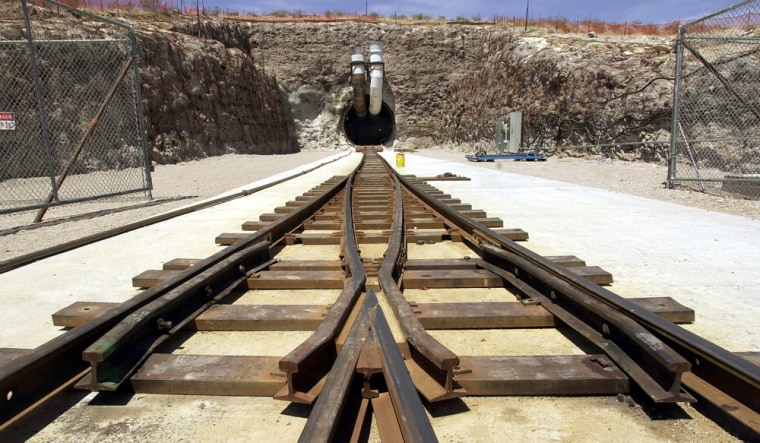No one knows what the Earth will be like in a million years. But a proposed nuclear waste dump in Nevada must be designed to ensure that people living near it then are exposed to no more than 100 millirems of radiation annually — equivalent to about a half-dozen X-rays.
And over the next 10,000 years, radiation exposure to the waste dump’s neighbors may be no more than 15 millirems a year, which is about what people get from an ordinary X-ray. People receive about 350 millirems a year of radiation on average from all background sources.
After three years of deliberations, the Environmental Protection Agency on Tuesday announced its radiation health standard for the proposed Yucca Mountain nuclear waste repository, a proposed system of underground caverns 90 miles northwest of Las Vegas where the government hopes to keep highly radioactive commercial and military nuclear waste.
It is scheduled to open in 2020 if a license application is approved by the Nuclear Regulatory Commission.
Court ordered the rules
The EPA has struggled to comply with a 2004 court directive that said it must establish a radiation health standard for a million years into the future because some of the isotopes in the buried waste will remain extremely dangerous for that long. An earlier standard of only 10,000 years was ruled inadequate by the court.
The agency said Tuesday it believes its latest standard is “consistent” with the recommendations of the National Academy of Sciences and is expected to satisfy the court decision.
The Energy Department last June submitted its license request for the Yucca Mountain dump to the NRC, which has three years to consider the request. Despite strong opposition from Nevada officials, the Bush administration hopes the site can be opened by 2020.
It is designed to hold 77,700 tons of used reactor fuel from commercial nuclear power plants in 31 states. The Energy Department recently estimated a cost of $96.2 billion of building and operating it for 150 years, beyond its expected closure date of 2113.
Climate, quakes, corrosion must be weighed
The EPA said that in submitting its design for a license, the Energy Department must consider the effects of climate change, earthquakes and volcanic activities as well as the corrosion of the waste packages to assure it can meet the radiation exposure requirements over a million years.
Energy Secretary Samuel Bodman has said he is confident that the license application submitted to the NRC will “stand up to any challenges anywhere,” including questions about whether the design will be adequate to meet the EPA’s radiation exposure standard to nearby residents.
Rep. Ed Markey, D-Mass., said the EPA announcement, coming four months after the Yucca application was sent to the NRC, “only reinforces how their entire approach to the Yucca Mountain nuclear waste project has put politics and the financial health of the nuclear industry ahead of science and the health of the public.”
Markey said the Energy Department should withdraw the application and resubmit it after the radiation exposure requirements are taken into account.
Kevin Kamps, of the anti-nuclear watchdog group “Beyond Nuclear,” called the 100 millirem threshold far too lax. He said it would allow “future generations to be exposed to significantly higher doses of harmful radiation” than people living near nuclear power plants today.
The NRC’s primary job will be to determine whether the proposed design will protect public health and meet the EPA radiation standard. The NRC has proposed a less stringent radiation standard. And the EPA itself had a maximum exposure of 350 millirems per year for the 10,000-to-1-million-year time frame, more than three times the exposure level it announced Tuesday.
